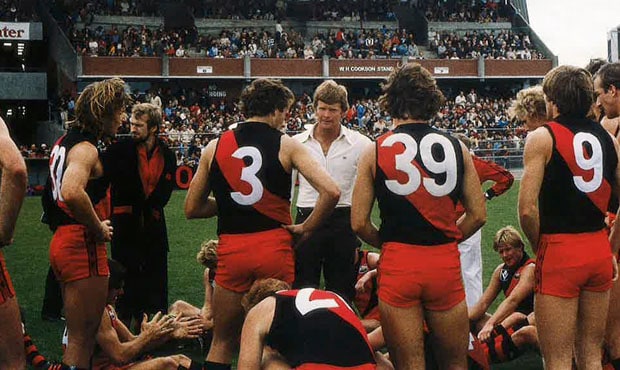Since foundation of the AFL/VFL there has only been two complete decades of no premiership success for Essendon – the 1930’s and 1970’s. Fingers crossed for the 2010’s.
In the 1960’s Essendon won two premierships, lost a Grand Final in ‘68 and participated in seven years of finals. This was on the back of the Reynolds handover to Coleman and the wonderful players of that decade in Clarke, Fraser, Shelton, McKenzie and Fordham etc.
I see the 70’s as a decade where Essendon adjusted and a sort of a half-way house between the domination of the 60’s and the modern era led by Kevin Sheedy. I was 17 when I started alongside Simon Madden, Ronnie Andrews and Garry Foulds. I saw the introduction of the likes of Watson, Vander Haar, Neagle, Hawker, Terry and Neale Daniher, Nobby Clarke, Merrett and Daisy Williams. The recruiting was strong and laid a foundation for success for well over the next decade.
The Club was in transition from a strong Essendon identity with coaches such as Clarke, Coleman and Birt and this led to one of Essendon’s biggest calls. For the first time since 1939 Essendon called in an outsider in Collingwood legend, Des Tuddenham. It was a move designed to inspire and make the team fiercely competitive. For a truly conservative Essendon this was a monumental move. Off the field the club was growing with the building of the social club in the early 70’s. A haven and meeting place for players and supporters. It greatly assisted bringing the Club closer together and building a strong bond.
Throughout the decade we played in three finals series. Tuddenham inspired Essendon and Essendon people loved the spirit of his teams. We saw the emergence of John Cassin, Kenny Roberts, Neville Fields and Gary Parkes - a group of highly competitive spirited youngsters. Essendon made the finals under Tuddenham in 1972 and 1973 but were beaten by St Kilda in the Elimination Final on both occasions. We had to wait six years to reach another final under Barry Davis only to again lose in the Elimination Final.
I was bought up in a different era where respect for coaches was non-negotiable. Yes, Tuddy was intimidating. But for a youngster to see a man with such a reputation train and play like he did was inspirational. Crippled by years of putting his body on the line Tuddy limped into most games, fiercely competing and driving his team on. His three-hour training sessions at the Showgrounds were relentless. Lap after lap of the trotting track, carrying sandbags with no access to water as that was a sign of weakness.
We also ran around Flemington – all 3,200 metres, Tuddy always in front. As with most of my horses that I have backed, I was gone at Chiquita Lodge. When we finished, Des would go round again by himself!
He is infamous for making us crawl around the ground on our hands and knees one Sunday morning. We led 5.1 to 1.4 at quarter time. Carlton responded with a 14.1 second quarter. Des responded the next morning. These days players wouldn’t cop it. But he was our coach and we followed. Des led the group as usual. He was inspirational and I loved him as a coach.
After the tough Des’ approach, the Club looked to another outsider in Fitzroy legend and true gentleman in Bill Stephen. He was a nurturer and guider, skill obsessed and looking to build a running team. He was the opposite to Tuddy and that’s probably why the club made the move. Bill is one of the great people I’ve met in football and later he became my mentor when I coached Fitzroy. It was skill, run and handball. You just wanted to play for such a good bloke.
A true great of Essendon replaced Stephen after two years. Barry Davis was physical education trained, an academic and a man of great standing in our community. It was the first time I had been exposed to the planning of training, set plays, and sports science. It was the first time I did skinfolds or max vo2 testing. It was the first time I played tempo football at the end of quarters. Davis called it ‘red time’. Slow down the quarter.

Barry Davis coached Essendon between 1978 and 1980.
I was so intrigued by Davis’ planning that I started to write down every drill and every training session. He inspired me to coach. He opened up my eyes to the importance of education and career planning. His drills were planned and organised. He was a perfectionist. So why did he fail?
Barry was Hird and Buckley in terms of preparation and training decades before they came on the scene. He was miles ahead of his time. Maybe that was the issue. Barry made a silly statement during 1980 that if Essendon didn’t make the finals he would retire and continue his teaching. He stuck to his word. A man of great standing and exemplary character. A coach truly before his time.
We were still in the ‘unprofessional seventies’ and like Dick Reynolds, Barry was frustrated with the larrikins that drank, smoked and had late nights. Dick had trouble with them and so did Barry. Gee history is interesting. Barry made the statement that he would step down if we didn’t make the finals. Imagine if we had made it. What then for the course of Essendon history. Barry Davis: a brilliant mind.
In October 1980 I finished cricket training and went to a meeting in the old players’ lounge. President Colin Stubbs addressed the group. “Players, I’d like to introduce the new coach of the Essendon Football Club. Please make welcome, Kevin Sheedy.”
Living in the 70’s by Skyhooks was released in 1974 so it was quite appropriate to our decade. In December we started training. ACDC had released their iconic album, Back in Black, at the time we started our campaign under Sheeds.
We were about to release our own album: Back in Red and Black.


